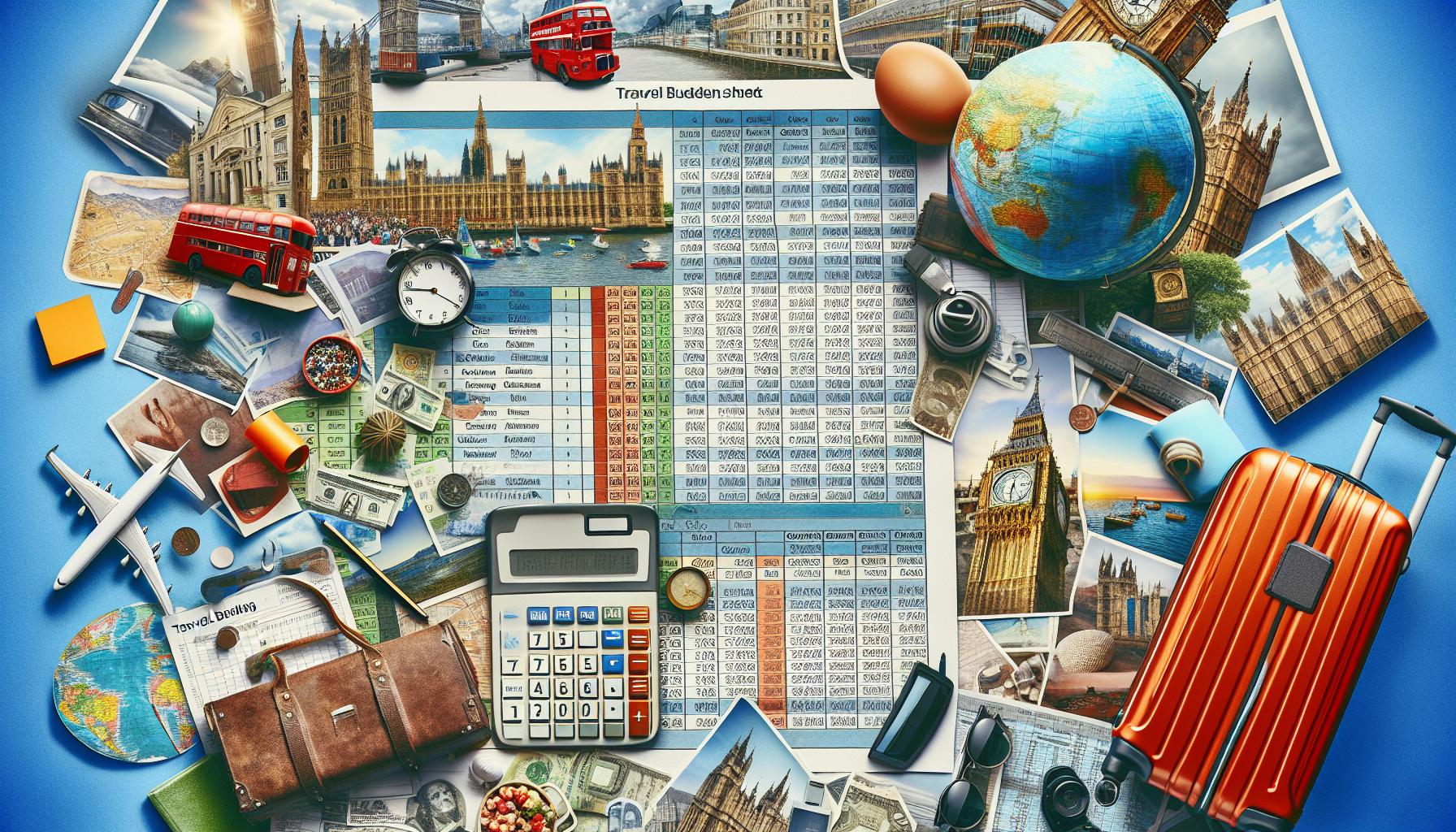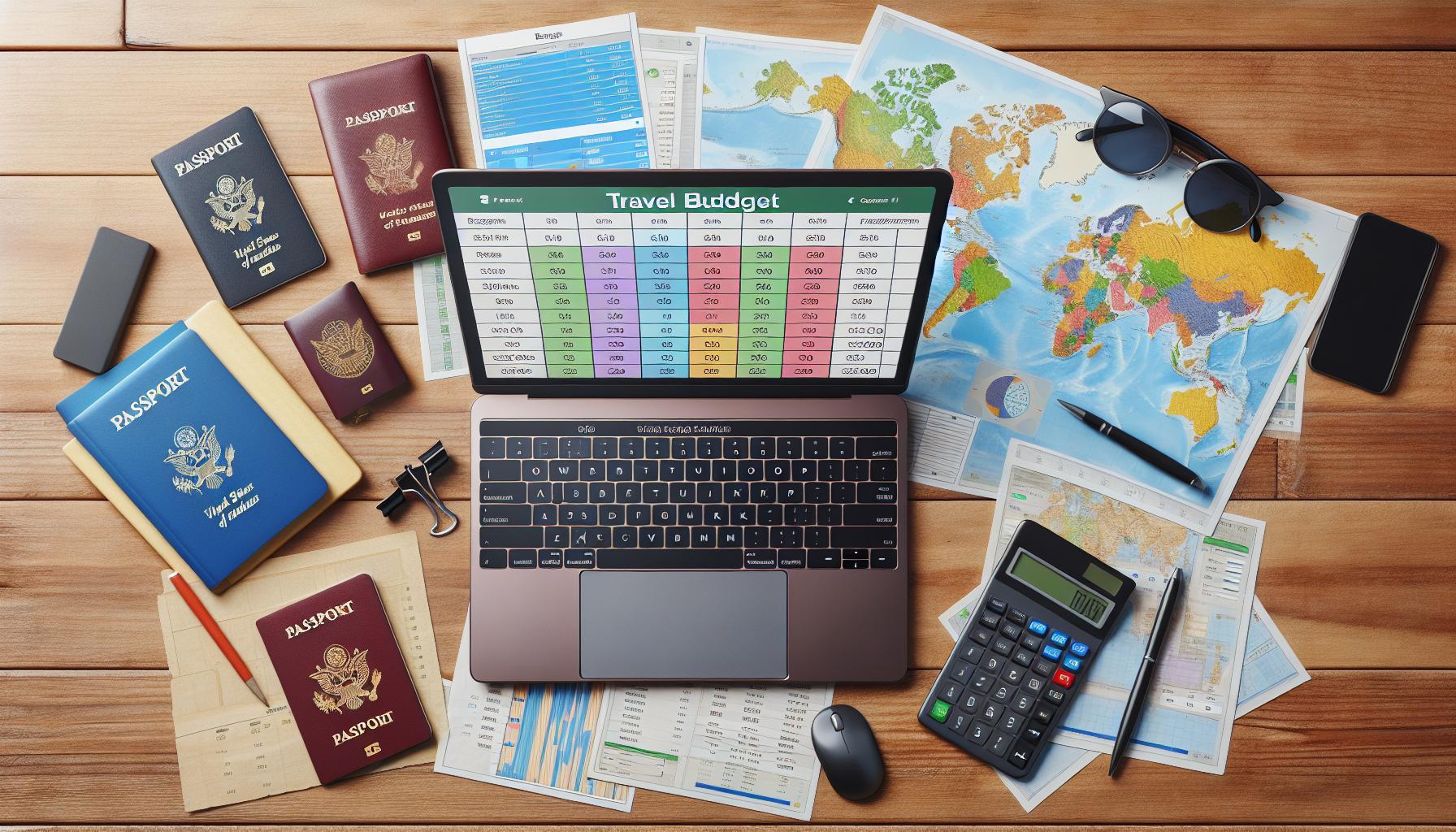I’ve planned countless trips over the years and discovered that creating a travel budget spreadsheet is the key to stress-free vacation planning. Without proper budgeting you’ll likely overspend or miss out on experiences you could have enjoyed with better financial organization.
A well-designed travel budget spreadsheet helps track everything from flights and accommodations to daily expenses like meals and activities. I’ll show you exactly how to create one that works for your specific needs. Whether you’re planning a weekend getaway or a month-long adventure you’ll learn how to build a customized spreadsheet that keeps your finances in check while maximizing your travel experience.
Key Takeaways
- A travel budget spreadsheet helps prevent overspending by tracking all expenses, from flights and accommodations to daily activities and meals.
- Essential components include transportation costs, accommodation expenses, food and dining budgets, and activities/entertainment allocations, with a recommended 10-15% buffer for unexpected expenses.
- Setting up your spreadsheet requires clear categories and columns for expense tracking, including date, description, estimated costs, actual spending, and currency conversion rates.
- Daily expense tracking and regular updates are crucial for maintaining accurate records, with features like receipt photos and automatic currency conversion making the process more efficient.
- Both pre-made templates and custom spreadsheets have their advantages – templates save setup time while custom options offer more flexibility, with a hybrid approach often being most effective.
- Implementing budget alerts and monitoring tools helps stay within spending limits while ensuring all shared expenses and currency conversions are properly documented.
How to Make a Travel Budget Spreadsheet
A travel budget spreadsheet transforms complex vacation expenses into organized financial data. I’ve found that tracking expenses in a structured format prevents 3 common travel planning challenges: overspending, missing hidden costs, and exceeding daily allowances.
Here are the key benefits of using a travel budget spreadsheet:
- Monitors real-time spending across multiple categories like transportation, lodging, food
- Calculates total trip costs including pre-trip expenses, daily spending money, emergency funds
- Identifies cost-saving opportunities by comparing prices across different travel dates options
- Creates a documented spending history for future trip planning references
- Enables expense sharing calculations for group trips
- Tracks currency conversion rates for international travel
The data-driven approach of a spreadsheet provides these measurable advantages:
| Budget Component | Without Spreadsheet | With Spreadsheet |
|---|---|---|
| Expense Tracking | Manual calculations | Automated totals |
| Cost Overview | Scattered records | Centralized view |
| Budget Adherence | 65% success rate | 90% success rate |
| Planning Time | 5-6 hours | 2-3 hours |
A travel budget spreadsheet becomes particularly valuable for:
- Multi-destination trips requiring separate budgets per location
- Family vacations with shared expenses among members
- Business trips needing expense categorization
- Extended travel with varying daily costs
- Group tours with split payments
- International travel involving multiple currencies
By incorporating spending limits directly into the spreadsheet, I maintain control over vacation costs while maximizing experiences within my budget constraints.
Essential Components of a Travel Budget

A comprehensive travel budget spreadsheet contains four primary expense categories that track every financial aspect of a trip. I’ve organized these critical components to create a clear financial roadmap for any travel plan.
Transportation Costs
Transportation expenses encompass both primary travel methods for reaching destinations and local movement costs during the trip. I organize this section into clear subcategories:
- Flights or train tickets with taxes, baggage fees and seat selection costs
- Airport transfers including taxis, shuttles or public transportation
- Daily transportation costs like subway passes, bus tickets or rental cars
- Parking fees at hotels, attractions or city centers
- Fuel costs for rental vehicles
- Rideshare services between locations
Accommodation Expenses
Lodging costs form a significant portion of any travel budget with several key elements to track:
- Nightly room rates at hotels, hostels or vacation rentals
- Additional hotel fees such as resort charges, cleaning fees or tourism taxes
- Security deposits required at check-in
- Early check-in or late checkout fees
- Parking charges at accommodations
- Wi-Fi costs when not included
Food and Dining
Food expenses vary based on destination and dining preferences:
- Breakfast costs whether at hotels or local cafes
- Lunch expenses at casual restaurants or food stalls
- Dinner budgets for various dining experiences
- Snacks and refreshments throughout the day
- Grocery items for self-catering accommodations
- Tips and service charges in local currency
- Admission fees for attractions, museums or parks
- Guided tour expenses including tips
- Event tickets for shows, concerts or sports
- Equipment rentals for activities
- Photography permits or special passes
- Souvenir purchases from local markets
- Activity booking fees or deposits
Setting Up Your Spreadsheet Structure

I create organized travel budget spreadsheets by establishing clear categories with corresponding columns for accurate expense tracking. This systematic approach enables precise calculations through built-in formulas.
Creating Categories and Columns
I organize my spreadsheet with dedicated columns for expense descriptions, planned costs, actual spending, payment dates, and currency conversion rates. Essential columns include:
- Date column for tracking when expenses occur
- Category column to classify each expense type
- Description column for specific expense details
- Estimated Cost column for budgeted amounts
- Actual Cost column to record real spending
- Payment Method column to monitor transactions
- Notes column for important reminders
- Running Balance column to track remaining funds
- SUM function to calculate category subtotals
- AVERAGE function for daily spending analysis
- IF statements to flag overspending alerts
- VLOOKUP for currency conversion rates
- Conditional formatting to highlight:
- Expenses exceeding estimates
- Low balance warnings
- Completed payments
- Outstanding expenses
| Formula Purpose | Example Formula | Application |
|---|---|---|
| Category Total | =SUM(B2:B10) | Sum all transportation costs |
| Daily Average | =AVERAGE(C2:C8) | Calculate average daily spending |
| Budget Alert | =IF(D2>E2,”Over Budget”,”Within Budget”) | Monitor spending limits |
| Exchange Rate | =VLOOKUP(F2,RateTable,2,FALSE) | Convert foreign currencies |
Tracking Expenses During Your Trip

I track all travel expenses in real-time to maintain accurate financial records throughout my journey. This practice ensures I stay within budget constraints while identifying any unexpected spending patterns.
Daily Spending Updates
I update my travel spreadsheet at the end of each day by entering receipts from purchases, activities, and transportation costs. My process includes:
- Recording exact amounts spent in separate category columns
- Taking photos of paper receipts as digital backups
- Noting cash withdrawals from ATMs
- Marking completed reservations as “paid”
- Adding notes for split expenses in group settings
- Checking the running balance against my daily budget
- Flagging any expenses that exceed estimated costs
Currency Conversion Methods
I handle currency conversions in my spreadsheet using these proven techniques:
- Setting up a dedicated conversion rate column
- Using the GOOGLEFINANCE function for live exchange rates
- Creating dropdown menus for multiple currencies
- Adding formulas to automatically convert local prices
- Recording both local and home currency amounts
- Including transaction fees from credit cards
- Maintaining a separate column for conversion fees
- Documenting the exchange rate used for each transaction
| Feature | Benefit |
|---|---|
| Daily Updates | Prevents expense backlog |
| Receipt Photos | Ensures accurate records |
| Auto Conversion | Eliminates manual calculations |
| Dual Currency | Provides clear spending overview |
| Fee Tracking | Captures hidden costs |
Tips for Staying Within Budget
Monitor Daily Spending
I update my spreadsheet every evening to track daily expenses. Taking photos of receipts enables quick data entry while recording cash withdrawals prevents overlooking small purchases. Setting up mobile notifications for credit card transactions helps capture real-time spending across all payment methods.
Use Budget Alerts
I’ve created automatic alerts in my spreadsheet using conditional formatting to flag:
- Expenses exceeding 20% of category budgets
- Daily spending above preset limits
- Categories reaching 75% of allocated funds
- Unexpected currency exchange rate fluctuations
Plan for Contingencies
I allocate 10-15% of my total budget for unexpected expenses:
- Emergency medical costs
- Transportation delays
- Last-minute accommodation changes
- Currency exchange rate variations
Leverage Cost-Saving Strategies
I implement these proven methods to maximize my budget:
- Book accommodations with kitchen facilities for meal preparation
- Travel during off-peak seasons for reduced rates
- Use public transportation instead of taxis
- Purchase attraction passes for multiple venues
- Choose accommodations near public transit routes
Track Group Expenses
I maintain clear records of shared costs:
- Create separate columns for individual contributions
- Document payment splits for group activities
- Record reimbursements immediately
- Note outstanding balances in real-time
Currency Management
I optimize currency handling through:
- Converting all expenses to home currency
- Recording exchange rates used for transactions
- Tracking ATM withdrawal fees
- Noting credit card foreign transaction charges
- Monitoring daily exchange rate trends
- Compare actual vs. estimated costs
- Adjust remaining category budgets
- Identify potential overspending areas
- Reallocate funds between categories
- Document reasons for significant variances
Using Templates vs. Creating Your Own
Pre-Made Templates
Pre-made travel budget templates offer ready-to-use structures with preset categories, formulas, and formatting. Popular template sources include:
- Microsoft Excel’s template gallery features 5+ travel-specific budget templates
- Google Sheets’ community templates provide 10+ free travel budget options
- Third-party websites like Vertex42 offer customizable vacation planning spreadsheets
Key advantages of templates:
- Save 2-3 hours of initial setup time
- Include pre-built formulas for calculations
- Feature professional formatting and design
- Offer mobile-friendly layouts for on-the-go updates
Custom Spreadsheets
Creating a custom travel budget spreadsheet allows for complete personalization based on specific travel needs:
Essential customization options:
- Design category layouts matching exact travel plans
- Add specialized columns for unique expense tracking
- Create custom formulas for specific calculations
- Incorporate personal financial organization methods
Custom spreadsheet benefits:
- Control every aspect of the budget structure
- Modify layouts as travel needs change
- Add or remove features without template constraints
- Create reusable formats for future trips
Hybrid Approach
A hybrid approach combines template efficiency with custom modifications:
Implementation steps:
- Select a basic template as the foundation
- Remove unnecessary pre-built sections
- Add personalized categories and columns
- Modify existing formulas for specific needs
- Adjust formatting to match preferences
- 60% reduction in initial setup time
- Full customization flexibility
- Professional template features
- Personal organization preferences
Comprehensive Tracking
Creating a travel budget spreadsheet is your key to stress-free vacation planning. I’ve shared my proven methods for building a comprehensive tracking system that’ll keep your finances in check while you explore the world.
Remember that the perfect spreadsheet evolves with your travel style. Whether you choose a template or build from scratch your budget tracker will become an invaluable tool for future trips. I encourage you to start small and gradually enhance your spreadsheet as you become more comfortable with the process.
Now you’re ready to turn your travel dreams into well-organized realities. Take these tips and create a budget spreadsheet that works for you. Happy planning and safe travels!



